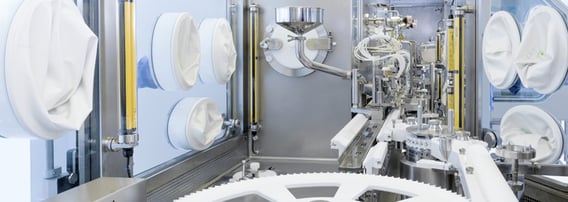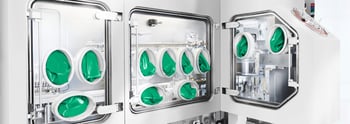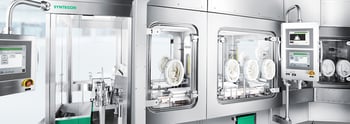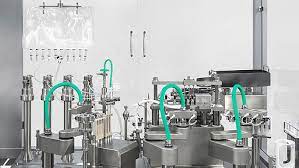Today, the processing of highly potent pharmaceuticals is becoming increasingly important. However, this is not the only trend that has an impact on the pharmaceutical industry. In this interview, Matthias Angelmaier, global product manager for barrier systems and isolator technology, not only gives answers to current trends and development opportunities, but also provides exciting insights behind the scenes of a product manager.

1. Matthias, what does a typical day look like as a product manager for barrier systems?
I work as a global product manager with responsibility for barrier systems and process technology. This concerns everything related to RABS, isolator systems, H2O2 bio-decontamination and high-potent isolator applications. As a product manager, no day is like the other. Starting with project discussions with customers on new systems and applications, to discussions with colleagues in development, design and process technology and through to the implementation of these requirements, as well as participation in Factory Acceptance Tests (FAT) in the assembly hall together with our customers, just to name a few.
2. What are the challenges in your area of responsibility?
Due to the increase in regulatory requirements globally, new customer groups have moved their focus of attention over the last couple of years. While the USA and Western Europe used to be core markets for isolator technology, this regional focus has changed dramatically. Meanwhile we see inquiries and installations in almost all parts of the world. One major challenge is the level of experience as well as the need for information by those new customer groups. The customized consulting and design of isolators and process technology to the respective requirements are an exciting field on one hand, but also very challenging on the other.
3. Which trends are currently in the spotlight and what opportunities for further developments do you see?
In my view, there are several global trends in the pharmaceutical industry that have a lasting impact on both filling machines and isolator technology.
The first topic is targeted medicine and appropriate small batch production. New forms of therapies are often customized to smaller patient groups and therefore require significantly fewer units than traditional forms of therapies. A consequence of this are modular machine concepts in order to react more flexible to different packaging materials and requirements. For isolators, this means modular concepts with the highest possible degree of integration. Topics such as integrated air management and bio-decontamination play an essential role in flexibly accommodating the systems in existing cleanrooms and facilities.
Biotech products comprise a large segment of these therapy areas. In many cases, these products are sensitive to residual H2O2 concentration levels after the aeration phase of the biodecontamination. Both the isolator system and the filling machine therefore need to be optimized for these requirements.
In my opinion, the second major topic are highly potent products. Oncological drugs are currently the largest research area within the pharmaceutical industry. There are numerous therapies in different clinical phases. Due to the high potency of some of these products, completely new challenges arise for the isolator systems in terms of operator protection.
I also see great potential in the nascent area of fully automated, robot-based, isolator systems. Current automation technology still requires manual intervention or support processes by operators. The complete elimination of these steps, and thus an increase in aseptic process reliability and quality, is the way forward in the future.
4. As an expert in barrier technology, how do you see the constantly increasing demand for higher production reliability and product quality in the pharmaceutical industry?
The use of barrier systems is an important component in increasing both product quality and production safety from an aseptic processing point of view. Out of many customer discussions, the clear worldwide trend for new RABS systems as the absolute minimum standard can be seen. Regardless of whether our customers choose RABS or isolator systems, handling and the associated operating processes are the key success factors of any barrier system.
The above-mentioned highly potent products segment is a major challenge both for facility design and in the subsequent operation of the facility and filling lines. We are nowadays talking about products that are only partially included in the traditional containment pyramids of many pharmacologists. Product-specific OELs of <0.1µg/m³ are no longer a rarity. In addition to the classic aseptic product protection, the isolators must also be designed to the highest degree for operator protection. In addition to various mechanical adaptations, the use of different filter systems and pressure concepts, additional attention must be given to the appropriate system design. The perfect isolator design is of little use if the fill-finish equipment inside the isolator cannot be cleaned or is not designed for wash-down. Therefore, the optimization of the entire system together with our customers is an important consideration.
5. What are your wishes for the future?
Exciting developments and cooperation projects with our worldwide customers in order to work together on solutions that take aseptic and highly potent production to the next level.
Matthias Angelmaier has a bachelor’s degree in industrial and mechanical engineering as well as a master’s degree in business development. He joined Syntegon, in 2009. During his first 3 years, he was a project manager for handling complex customer projects. Since 2012, he has been the globally responsible product manager for barrier systems and isolator technology. His expertise includes process engineering, sterilization, bio-decontamination, aseptic and high-potent Isolator applications, glove testing systems as well as topics related to advanced aseptic processing.




